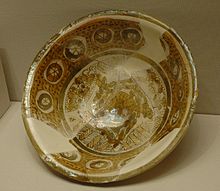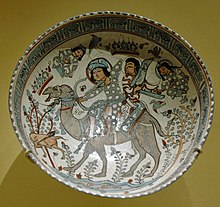Persian pottery

Bowl with Kufic Inscription, 10th century. Brooklyn Museum.

Pottery Vessel, 4th millennium BC

Lustreware bowl from Susa, 9th century

Bowl with a hunting scene from the tale of the 5th-century king Bahram Gur and Azadeh, mina'i ware

Persian Pottery from Isfahan, 17th century.
Persian pottery or Iranian pottery refers to the pottery works made by the artists of Persia (Iran) and its history goes back to early Neolithic Age (7th millennium BCE).[1]
Through the centuries, Persian potters have responded to the demands and changes brought by political turmoil by adopting and refining newly introduced forms and blending them into their own culture. This innovative attitude has survived through time and influenced many other cultures around the world.
The Islamic prohibition on using vessels made of precious metal at the table, which had been usual for pre-Islamic elites of the earlier Persian empires, meant that a market for luxury ceramics opened up, which Persian potters were able to fill with fancy glazes such as in lustreware and high-quality painted decoration.
Contents
1 Early pottery from Susa
2 Early Islamic period
3 Safavid period
4 Contemporary
5 Collections
6 Notes
7 References
8 External links
Early pottery from Susa
Susa was firmly within the Sumerian Uruk cultural sphere during the Uruk period. An imitation of the entire state apparatus of Uruk, proto-writing, cylinder seals with Sumerian motifs, and monumental architecture, is found at Susa. Susa may have been a colony of Uruk. As such, the periodization of Susa corresponds to Uruk; Early, Middle and Late Susa II periods (3800–3100 BCE) correspond to Early, Middle, and Late Uruk periods.
Shortly after Susa was first settled 6000 years ago, its inhabitants erected a temple on a monumental platform that rose over the flat surrounding landscape. The exceptional nature of the site is still recognizable today in the artistry of the ceramic vessels that were placed as offerings in a thousand or more graves near the base of the temple platform. Nearly two thousand pots were recovered from the cemetery and now, most of them now are located in the Louvre; one such vessel is the Bushel with ibex motifs. The vessels found are eloquent testimony to the artistic and technical achievements of their makers, and they hold clues about the organization of the society that commissioned them.[2] Painted ceramic vessels from Susa in the earliest first style are a late, regional version of the Mesopotamian Ubaid ceramic tradition that spread across the Near East during the fifth millennium B.C.[2]
Susa I style was very much a product of the past and of influences from contemporary ceramic industries in the mountains of western Iran. The recurrence in close association of vessels of three types—a drinking goblet or beaker, a serving dish, and a small jar—implies the consumption of three types of food, apparently thought to be as necessary for life in the afterworld as it is in this one. Ceramics of these shapes, which were painted, constitute a large proportion of the vessels from the cemetery. Others are course cooking-type jars and bowls with simple bands painted on them and were probably the grave goods of the sites of humbler citizens as well as adolescents and, perhaps, children.[3] The pottery is carefully made by hand. Although a slow wheel may have been employed, the asymmetry of the vessels and the irregularity of the drawing of encircling lines and bands indicate that most of the work was done freehand.
Early Islamic period
The Samanid period saw the creation of epigraphic pottery. These pieces were typically earthenware vessels with black slip lettering in Kufi script painted on a base of white slip. These vessels would typically be inscribed with benedictions or adages.[4]Samarqand and Nishapur were both centers of production for this kind of pottery.[5]
Innovations in ceramics from this period include the production of minai ware, enamelled with figures on a white background, and use fritware, a silicon-based paste, rather than clay.[6] Metalworkers highlighted their intricate hammered designs with precious metal inlays.[7]
One potter, Abū Zayd ibn Muḥammad ibn Abī Zayd (active c. 1186 – 1219, Kashan) has signed 15 surviving pieces, more than any other medieval Iranian potter.[8]
Safavid period

Plate decorated with two pomegranates, v. 1500, the Louvre

Tile with young man. Earthenware, painted on slip and under transparent glaze. Northwestern Iran, Kubachi ware, 17th century.
The study and dating of ceramics under Shah Ismail and Shah Tahmasp is difficult because there are few pieces which are dated or which mention the place of production. Chinese porcelain was collected by the elite, and was more highly valued than the local productions; Shah Abbas I donated much of the royal collection to the shrines at Ardabil and Mashhad, renovating a room at Ardabil to display pieces in niches.[9] Many locations of workshops have been identified, although not with certainty, in particular: Nishapur, Kubachi ware, Kerman (moulded monochromatic pieces) and Mashhad. Lusterware was revived, using a different technique from the earlier production, and typically making small pieces with a design in a dark copper colour over a dark blue background. Unlike other wares, these use traditional Middle Eastern shapes and decoration rather than Chinese-inspired ones.[10]
In general, the designs tend to imitate those of Chinese porcelain, with the production of blue and white pieces with Chinese form and motifs, with motifs such as chi clouds, and dragons.[11] The Persian blue is distinguished from the Chinese blue by its more numerous and subtle nuances. Often, quatrains by Persian poets, sometimes related to the destination of the piece (allusion to wine for a goblet, for example) occur in the scroll patterns. A completely different type of design, much more rare, carries iconography very specific to Islam (Islamic zodiac, bud scales, arabesques) and seems influenced by the Ottoman world, as is evidenced by feather-edged anthemions (honeysuckle ornaments) widely used in Turkey. New styles of figures appeared, influenced by the art of the book: young, elegant cupbearers, young women with curved silhouettes, or yet cypress trees entangling their branches, reminiscent of the paintings of Reza Abbasi.
Numerous types of pieces were produced: goblets, plates, long-necked bottles, spittoons, etc. A common shape is flasks with very small necks and bodies flattened on one side and very rounded on the other. Shapes borrowed from Islamic metalwork with decoration largely inspired by Chinese porcelain are characteristic.[12] With the closing of the Chinese market in 1659, Persian ceramic soared to new heights, to fulfill European needs. The appearance of false marks of Chinese workshops on the backs of some ceramics marked the taste that developed in Europe for far-eastern porcelain, satisfied in large part by Safavid production. This new destination led to wider use of Chinese and exotic iconography (elephants) and the introduction of new forms, sometimes astonishing (hookahs, octagonal plates, animal-shaped objects).
Contemporary
One of the main areas in Iran that has a very special way of producing pottery is Kalpuregan. Kalpuregan village is located in south east of Iran. The only characteristic that distinguishes Kalpuregan from other areas is its indigenous pottery, creation of civilization by Baluchi women artists. According to one of the village elders, manufacturing practices dating back to about 4 to 6 thousand years ago still remains intact. The only workshop that is still active and persistent to continue working with primitive method is Kalpuregan pottery workshop.
Throughout the history the art of pottery in Kalpuregan has belonged to women since men had the burden of hunting or farming. According to historical evidence, indigenous women are creators of pottery art. In this land, delicate tasks are done by women and men only have the responsibility of preparing and firimg the clay.
Another thing that distinguishes pottery of the region from other parts of the country is that women in Kalpuregan do not use pottery wheel to make pottery. It is amazing that such a magnificent work is possible only with traditional and innovative methods and the help of rural women's loving cracked hands. Potteries in this area learn this art from their mothers or clan women.
Paintings on pottery are abstract symbols that remained from generation to generation and indicate the artist’s beliefs and spiritual desires of her surroundings. Often symbolic paintings are similar to early prehistoric pottery. Indigenous artist women in this area believe they should use simple and abstract geometric patterns to paint pottery pieces exactly like their Ancestors.[13]
Collections
There are large collections of Persian pottery at the British Museum, the Hermitage Museum, the Royal Ontario Museum, and elsewhere. In 2013, the Royal Ontario Museum, in partnership with Brill Publishers in the Netherlands, published a special book about this art entitled "Persian Pottery in the First Global Age".[14]
| Persian art |
|---|
 |
Visual arts |
|
Decorative arts |
|
Literature |
|
Performance arts |
|
Other |
|
Notes
^ "The History of Persian Ceramics". California Academy of Sciences. 2010-02-02. Retrieved 2014-07-09..mw-parser-output cite.citation{font-style:inherit}.mw-parser-output .citation q{quotes:"""""""'""'"}.mw-parser-output .citation .cs1-lock-free a{background:url("//upload.wikimedia.org/wikipedia/commons/thumb/6/65/Lock-green.svg/9px-Lock-green.svg.png")no-repeat;background-position:right .1em center}.mw-parser-output .citation .cs1-lock-limited a,.mw-parser-output .citation .cs1-lock-registration a{background:url("//upload.wikimedia.org/wikipedia/commons/thumb/d/d6/Lock-gray-alt-2.svg/9px-Lock-gray-alt-2.svg.png")no-repeat;background-position:right .1em center}.mw-parser-output .citation .cs1-lock-subscription a{background:url("//upload.wikimedia.org/wikipedia/commons/thumb/a/aa/Lock-red-alt-2.svg/9px-Lock-red-alt-2.svg.png")no-repeat;background-position:right .1em center}.mw-parser-output .cs1-subscription,.mw-parser-output .cs1-registration{color:#555}.mw-parser-output .cs1-subscription span,.mw-parser-output .cs1-registration span{border-bottom:1px dotted;cursor:help}.mw-parser-output .cs1-ws-icon a{background:url("//upload.wikimedia.org/wikipedia/commons/thumb/4/4c/Wikisource-logo.svg/12px-Wikisource-logo.svg.png")no-repeat;background-position:right .1em center}.mw-parser-output code.cs1-code{color:inherit;background:inherit;border:inherit;padding:inherit}.mw-parser-output .cs1-hidden-error{display:none;font-size:100%}.mw-parser-output .cs1-visible-error{font-size:100%}.mw-parser-output .cs1-maint{display:none;color:#33aa33;margin-left:0.3em}.mw-parser-output .cs1-subscription,.mw-parser-output .cs1-registration,.mw-parser-output .cs1-format{font-size:95%}.mw-parser-output .cs1-kern-left,.mw-parser-output .cs1-kern-wl-left{padding-left:0.2em}.mw-parser-output .cs1-kern-right,.mw-parser-output .cs1-kern-wl-right{padding-right:0.2em}
^ ab Aruz, Joan (1992). The Royal City of Susa: Ancient Near Eastern Treasures in the Louvre. New York: Abrams. p. 26.
^ Aruz, Joan (1992). The Royal City of Susa: Ancient Near Eastern Treasures in the Louvre. New York: Abrams. p. 29.
^ McWilliams, Mary. "Bowl Inscribed with a Saying of 'Ali ibn Abi Talib". Harvard Art Museums. Retrieved 7 July 2015.
^ Volov, Lis (1966). "Plaited Kufic on Samanid Epigraphic Pottery". Ars Orientalis. 6 (1966): 107-33.
^ Piotrovsky & Rogers, 64–73
^ Piotrovsky & Rogers, 78–93
^ "Abu Zayd." In Grove Art Online. Oxford Art Online, (accessed February 5, 2012; subscription required).
^ Canby (2009), 101-104, 121-123, 137-159
^ Blair & Bloom, 171
^ Blair & Bloom, 171
^ Canby (2009), 162-163, 218-219
^ Art, Far Way. "Indigenous pottery in Kalpuregan (Iran)". Far Way Art. Retrieved 2018-04-18.
^ "Persian Pottery in the First Global Age". Brill/ROM. Retrieved 2014-07-09.
References
- Blair, Sheila, and Bloom, Jonathan M., The Art and Architecture of Islam, 1250–1800, 1995, Yale University Press Pelican History of Art,
ISBN 0300064659
- Canby, Sheila R. (ed), 2009, Shah Abbas; The Remaking of Iran, 2009, British Museum Press,
ISBN 9780714124520
- Piotrovsky M.B. and Rogers, J.M. (eds), Heaven on Earth: Art from Islamic Lands, 2004, Prestel,
ISBN 3791330551
External links
- Important Pieces of Persian Pottery in London
- Fashion technique in Persian pottery - Metropolitan Museum
- Persian Miniatures & Pottery; an Exhibition at Brooklyn Museum in 1935
